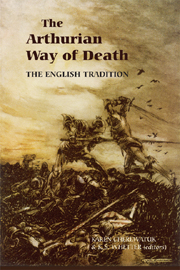Book contents
- Frontmatter
- Contents
- Illustrations and Tables
- Dedication
- List of Contributors
- Introduction
- Part I The early Tradition in england
- Part II Middle English Romance and Malory
- Part III Medieval Influence and Modern Arthuriana
- 10 Arthurian Exits: Alone, Together, or None of the Above
- 11 Woman as Agent of Death in Tennyson's Idylls of the King
- 12 Death as ‘Neglect of Duty’ in Howard Pyle's The Story of the Grail and the Passing of Arthur
- 13 Death and the ‘grimly voice“ in David Jones's In Parenthesis
- 14 Roll the Final Credits: Some Notes on Cinematic Depictions of the Death of Arthur
- Index
- Arthurian Studies
10 - Arthurian Exits: Alone, Together, or None of the Above
from Part III - Medieval Influence and Modern Arthuriana
Published online by Cambridge University Press: 12 September 2012
- Frontmatter
- Contents
- Illustrations and Tables
- Dedication
- List of Contributors
- Introduction
- Part I The early Tradition in england
- Part II Middle English Romance and Malory
- Part III Medieval Influence and Modern Arthuriana
- 10 Arthurian Exits: Alone, Together, or None of the Above
- 11 Woman as Agent of Death in Tennyson's Idylls of the King
- 12 Death as ‘Neglect of Duty’ in Howard Pyle's The Story of the Grail and the Passing of Arthur
- 13 Death and the ‘grimly voice“ in David Jones's In Parenthesis
- 14 Roll the Final Credits: Some Notes on Cinematic Depictions of the Death of Arthur
- Index
- Arthurian Studies
Summary
A good death scene certainly makes the story live on, and Western culture's ten-century love affair with the Arthurian legend stems in part from fascination with how certain characters die. Or not. Arthurian literature boasts several unforgettable demises, with Arthur himself and the two pairs of adulterous lovers, Lancelot and Guinevere and Tristan and Isolda, figuring among the most perennially fascinating. Starting with the birth of romance in the twelfth century, the story of Arthur's kingdom almost presumes the complications posed by the affair between Lancelot and Guinevere, and that affair often co-exists with the one between Tristan and Isolda. Thus the five figures repeatedly share narrative space, consistently serve as exemplars of chivalric and courtly culture, and appropriately persist in modern fascination with the story. Arthur and his circle are not the only legendary figures whose popular appeal continues in contemporary culture, but the degree to which the end of their story evolves makes them almost unique. In chronicle, Arthur's death is a military event with the appropriate political consequences; the four lovers are unimportant. With the development of romance, the five deaths in question here reflect interest in the characters' psychology, especially their attempts to reconcile the demands of their passion with their obligations to lord and God. While such concerns persist in literature even today, the end of these characters' stories also provides a context in which writers explore particularly modern preoccupations such as egalitarian societies and feminist spirituality.
- Type
- Chapter
- Information
- The Arthurian Way of DeathThe English Tradition, pp. 169 - 192Publisher: Boydell & BrewerPrint publication year: 2009



